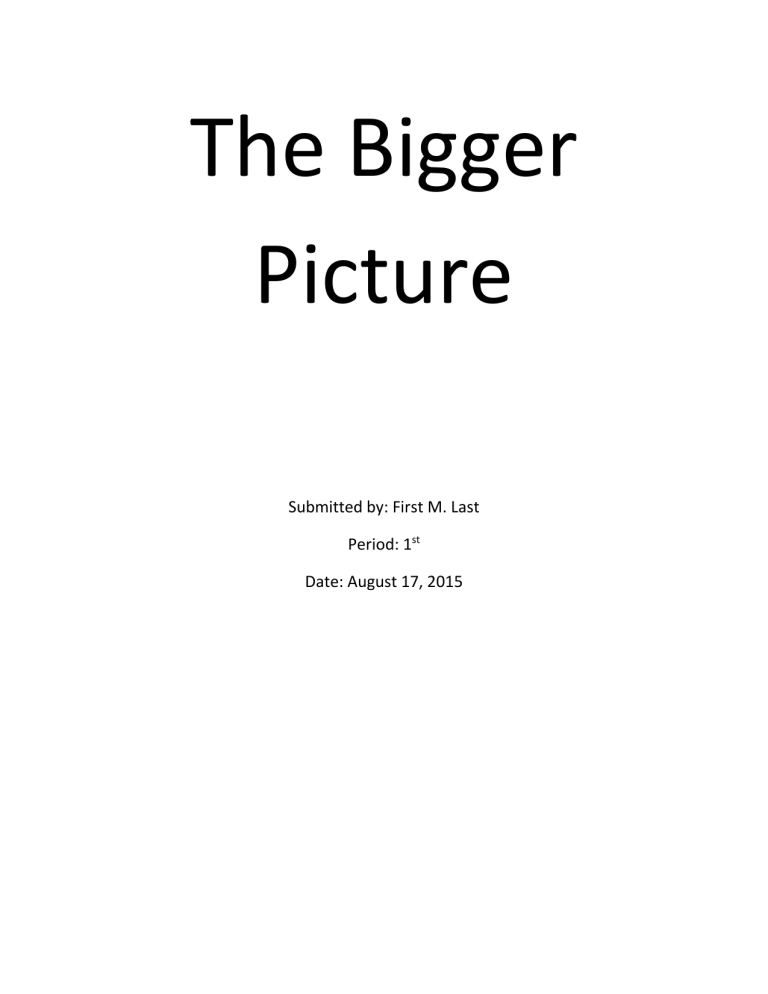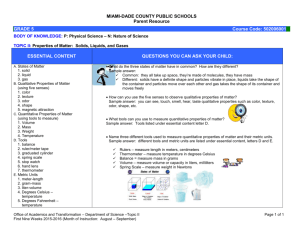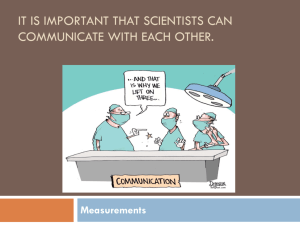File

The Bigger
Picture
Submitted by: First M. Last
Period: 1 st
Date: August 17, 2015
Abstract/Summary
The focus of this project is to determine how to measure larger and smaller objects more precisely and to determine which is more accurate, English or
Metric measurements.
To conduct this experiment, five objects in the class were pre-selected and then measured using various measuring techniques including length, temperature and when possible, weight. Qualitative measurements were used to support the quantitative measurements. The measurements were taken in both English and
Metric standards and then converted into the opposing standard and then compared.
It was determined that the metric measurements were more accurate than
English measurement particularly at extremely small items, and extremely large items. The conversions were on the average off by .2 of a degree in all measurements.
Problem:
Which is more accurate: English or Metric measurements on large and small objects?
Hypothesis:
It is hypothesized that the metric measurement system will be more accurate when measuring very large and very small objects, as compared to the conversions of the measurements and the English system of measurement.
Purpose/Theory:
The purpose of this lab exercise is to determine and learn the different methods of quantitative and qualitative data analysis of large and small objects, to practice conversion methods between English and Metric and within the metric system to determine the most accurate measurement system at the different size levels.
Research:
Data analysis is the practice of getting data, and then going over it or converting it to determine the results of an effort, like experimentation. This analysis is then used to determine a conclusion, as well as to communicate information about the effort a person did. Data are the descriptions taken from the exercise, which are the spoken or written representation or account of a person, object, or event (Dictionary.com, 2015).
The English system of measurement is a system of weights and measures such as the inch, yard, quart, ounce and pound that evolved over time and was used throughout most of the world. The system was developed out of necessity and there was no major standard in the measurements other than the existing use of a standard of measurement already established by others and by opinion.
For instance, the Romans liked the number 12, so they produced the 12 inches to produce a foot base. Very few countries still use this method of measurement, the primary country still using this method of measurement is the United States, who has not converted to the traditional metric method of measurement due to the cost of conversion of the standards that make up the English system
(study.com, 2015). The inch is a unit of linear measure equal to one twelfth of a foot (2.54 cm) (Dictionary.com, 2015).
The metric system (or Scientifique International – SI) unit of measurement is the primary system of measurement in most other countries, while the United
States uses both English and Metric systems. The metric system is based on 10’s.
The metric system uses units such as meter, liter, and gram to measure length, liquid volume, and mass. The “power of ten” measurement indicates that units within the system get larger or smaller by a power of 10. This means that a meter is 100 times larger than a centimeter, and a kilogram is 1,000 times heavier than a gram (Monterey Institute, 2015). The basic measurement of length in the metric system is a meter, which is equal to 100 centimeters or approximately 39.37 inches (Dictionary.com, 2015).
Common Measurements in Customary and Metric Systems
Length 1 centimeter is a little less than half an inch.
1.6 kilometers is about 1 mile.
1 meter is about 3 inches longer than 1 yard.
Mass 1 kilogram is a little more than 2 pounds.
28 grams is about the same as 1 ounce.
Volume 1 liter is a little more than 1 quart.
4 liters is a little more than 1 gallon.
(Monterey Institute, 2015)
Prefixes in the Metric System kilohectodekamet er gra m liter decicentimilli-
1,000 times larger t han base unit
100 times larger t han base unit
(Monterey Institute, 2015)
10 times larger t han base unit base units
10 times smaller t han base unit
100 times smaller t han base unit
1,000 times smaller t han base unit
The names of metric units are formed by adding a prefix to the basic unit of measurement. To tell how large or small a unit is, look at the prefix. To tell whether the unit is measuring length, mass, or volume, look at the base
(Monterey Institute, 2015).
A qualitative measurement is a measurement that relates or measures the quality such as color, texture or shape of an object. A quantitative measurement is numerical and measured using measuring instruments such as length, width, height, mass, temperature, volume, etc. (dictionary.com, 2015). Measurement instruments include items such as rulers, scales, water displacement, thermometers, and other items marked off in pre-established measurements.
Qualitative measurement includes using the five senses: sight, sound, touch, taste, and smell. The data taken from these measurements are then analyzed and placed into forms of presentation such as tables and graphs to see if the hypothesis is answered or rejected, to draw a conclusion from the data and evidence collected in the experiment.
Materials:
Equipment
Meter Sticks
Notebook
100 mL Beaker (1)
100 mL graduated cylinder (1)
Lab Table
Paper
Forceps
Scale
Chemicals
Water
Vinegar
Food coloring
Thermometer
Microscope
Microscope Slides
Ruler
Pipette
Biological
Plant leaf
Hair
Procedure:
1.
Students will measure each item’s length, width, height, and other quantitative measurements with measuring implements provided.
2.
Graph quantitative data to compare, and place qualitative data into a table.
3.
Convert each number from the quantitative measures into 2 smaller and 2 larger levels, as well as convert to English measurement.
4.
Measure in English and repeat steps 2 and 3.
5.
Each team should present their findings to the class and compare the accuracy of their measurements particularly with other students who measured similar items.
Observations
The easiest observations to take for the majority of the items selected were the overall area (length, width and height) and temperature. The qualitative data was more difficult to determine because what one person sees is not necessarily what the next person sees, particularly with color.
The majority of the quantitative measurements were accurate compared to the qualitative measurements, particularly in understanding the dimensions of the object precisely. The smaller objects were more accurately measured with the metric system. Metric had a slightly more accurate report than the English measurements both before conversion and after, and overall the direct measurements were more accurate than the conversions on the average of .2 of a unit on all measurements.
L/W/H
(cm)
Item 1 21/13/11 19
Item 2 None 16
Item 3 11/2/2
Weight (g) Color
3
Red
Clear
Silver
Shape
Square
Liquid
Smell/Touch
Woody
Sharp/Cool
Long/Narrow Metallic/Cold
Item 4 33/1/33 42
Item 5 28.2/2/2.4 27
Green
Pink
Roundish
Roundish
Woody/Smooth
No smell/Smoothish
30
20
10
0
70
60
50
40
80
Deg. F Measurements vs. Converted
oF
Converted oF
Item 1 Item 2 Item 3 Item 4 Item 5
5
0
20
15
10
25
Deg C Measurements vs. Converted
oC
Converted oC
Item 1 Item 2 Item 3 Item 4 Item 5
(can add diagrams & pictures, which should be captioned and labelled, should be more graphs of all quantitative measurements and comparisons. )
The data collected was placed into tables and the final result was charted as numerous items of data were used to produce the measurements. There was a noticeable difference in the conversion numbers versus the actual measurements in particularly the temperatures as indicated in the graphed data. The converted numbers were generally off by between two tenths of a unit and four tenths of a unit between Fahrenheit and Celsius. This may have been caused by a variation of temperature in the room between measurements, an error in calculations, or an actual variance in the mathematical conversion versus the physical conversion. It was also noted that the metric system was more accurate in determining the measurements for very large and very small items, including the microscopic measurements. Both seemed to be moderate and average for the middle-level measurements, though the English measurements had large variances not only with this experiment but also between teams, while the Metric measurements were almost nearly all identical and precise. A potential source of error was that the measurement instruments may not have all been calibrated ahead of time, therefore producing slightly varying results, which could be investigated in the future to enhance the data analysis of this experiment. It was also noted that the
beaker was +/- 3 mL difference from the graduated cylinder, therefore producing a slightly different measurement between the measurement items. It was determined that the graduated cylinder was far more accurate than the beaker of the same size, and such was even indicated on the side of the beaker.
Conclusion:
Upon conducting the experiment and analyzing the data it can be concluded that all items that were measured were identified primarily through the quantitative data, and most accurately with the Metric system of measurement. The physical measurements were more accurate than the conversions and once again, the Metric system of measurement was more thorough and accurate than the English measurements. The quantitative data could be converted in both larger and smaller directions as well as between
English and Metric measurements. It was noted that there was a slight discrepancy in the calculated measurements versus the physical measurements particularly in temperature, where the physical measurement was different from the calculated conversion measurement by a few tenths of a point. This showed up in all measurements. This data supports the hypothesis as stated and therefore the hypothesis is accepted. Further experimentation could include more items, as well as a comparison of digital versus mechanical measuring devices for accuracy.
Bibliography/Works Cited
Dictionary.com. 2015. General definitions. http://dictionary.reference.com/
Monterey Institute. 2015. “The Metric System of Measurement” http://www.montereyinstitute.org/courses/DevelopmentalMath/COURSE_
TEXT_RESOURCE/U06_L2_T1_text_final.html
Study.com. 2015. “English System Of Measurement: Definition, History,
Advantages & Disadvantages”. http://study.com/academy/lesson/englishsystem-of-measurementdefinition-history-advantages-disadvantages.html






